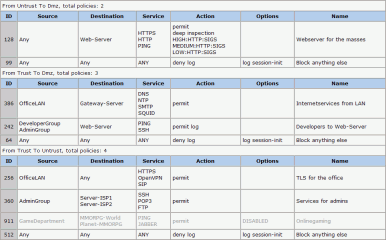Junipiper
by Philipp Schweizer
latest version: 1.37 (September 2010)
Introduction
Junipiper exports policies and zones from a ScreenOS (TM) configfile
to a htmlpage. This is needed, if you want to document the configuration of
your Juniper (TM) SSG firewall. Those documentation is often used for PCI-
Certification or regulary audits of the firewall ruleset. Normally, you would
get those informations directly from the WebUI of the firewall. But the WebUI
is missing some things, like:
- a list of all policies at once and not just 100 per page (useful if you have lots of policies)
- display of the "name"-field for every policy (helpful for explaining the reason of a policy)
To make reading the generated htmlpage as easy as possible, it is styled in a
similar way like the original policy display of the firewall.
If you need the generated documentation in a spreadsheet-format like Excel (TM)
or Open Office Calc (TM), than just drag the htmlfile into a new spreadsheet.
This works very well with Excel 2007 (TM) and Open Office Calc 3.2 (TM).
The development of this tool is done for fun and in spare time. So please do not
expect monthly releases cycles or other professional habits. For feedback,
improvements, bugreports or other stuff just write to:
junipiper (at) sciencefrontiers (dot) org
How to use
A usage information will be shown, if you just start Junipiper without any commandline parameters.
Usage: junipiper [-v/-vv] [-a] configfile [htmlfile]
-v Verbose output
-vv Very verbose output
-a Active policies only
configfile Name of the configfile (source)
htmlfile Optional: name of the htmlfile (target)
Examples
Commandline example:j:\>junipiper -vv my_cfg.txt
Checking configfile (my_cfg.txt)...
Lines counted: 85
Loading configfile (my_cfg.txt)...
Checking policies...
Policies counted: 9
Loading policies...
Sorting zones...
Zones counted: 3
Writing htmlfile (my_cfg.html)...
Finished htmlfile (my_cfg.html).
(generates a htmlpage called: my_cfg.html)
Generated htmlpage example:

License
As this program is free of charge, there is no warranty for
the program or it's functionality, use it at your own risk.
Selling or redistribution of this program is not allowed
without a written permission from the author.
Download
Windows: Junipiper 1.37 - junipiper.zip (10KB)
Linux: Junipiper 1.37 - junipiper.tgz (13KB)
Version history
September 2010
Junipiper 1.37:
- disabled policies are now greyed out
- parameter for exporting only active policies (requested by R. Niebuhr)
July 2010
Junipiper 1.33:
- initial release
If you think, that Junipiper is not versatile enough, you can also take a look at:
ns2html